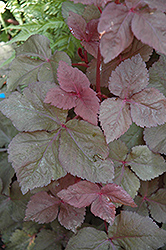Fri & Sat 8am - 8pm
Sun 8am - 7pm
Anytown, USA 12345
fax: 261.787.0463
e-mail: info@successgc.com


Plant Finder

Purple-Leafed Mitsuba
Cryptotaenia japonica 'Atropurpurea'
Plant Height: 18 inches
Flower Height: 24 inches
Spread: 12 inches
Sunlight:
![]()
![]()
Hardiness Zone: 4a
Other Names: Japanese Parsley, Japanese Honeywort
Description:
Also known as Japanese parsley, this variety forms a low mound of purple-black foliage making it a perfect contrast plant; small umbrels of white flowers appear in summer; leaves and stems have a celery-like flavor but may be toxic in large quantities
Edible Qualities
Purple-Leafed Mitsuba is a perennial herb that is commonly grown for its edible qualities. The serrated heart-shaped purple leaves with distinctive burgundy veins which emerge grayish green in spring are usually harvested from late spring to late summer. The leaves have a sweet taste.
The leaves are most often used in the following ways:
- Fresh Eating
- Cooking
- Sauces
Features & Attributes
Purple-Leafed Mitsuba features airy spikes of white flowers rising above the foliage in mid summer. Its serrated heart-shaped leaves emerge grayish green in spring, turning purple in color with distinctive burgundy veins throughout the season.
This is a dense herbaceous perennial herb with an upright spreading habit of growth. Its medium texture blends into the garden, but can always be balanced by a couple of finer or coarser plants for an effective composition. This plant will require occasional maintenance and upkeep, and should be cut back in late fall in preparation for winter. Gardeners should be aware of the following characteristic(s) that may warrant special consideration;
- Self-Seeding
Aside from its primary use as an edible, Purple-Leafed Mitsuba is sutiable for the following landscape applications;
- Mass Planting
- Border Edging
- General Garden Use
- Herb Gardens
- Container Planting
Planting & Growing
Purple-Leafed Mitsuba will grow to be about 18 inches tall at maturity extending to 24 inches tall with the flowers, with a spread of 12 inches. Its foliage tends to remain dense right to the ground, not requiring facer plants in front. It grows at a medium rate, and under ideal conditions can be expected to live for approximately 10 years. As an herbaceous perennial, this plant will usually die back to the crown each winter, and will regrow from the base each spring. Be careful not to disturb the crown in late winter when it may not be readily seen!
This plant is typically grown in a designated herb garden. It does best in full sun to partial shade. It does best in average to evenly moist conditions, but will not tolerate standing water. It is not particular as to soil type or pH. It is somewhat tolerant of urban pollution. This is a selected variety of a species not originally from North America. It can be propagated by division; however, as a cultivated variety, be aware that it may be subject to certain restrictions or prohibitions on propagation.
Purple-Leafed Mitsuba is a good choice for the edible garden, but it is also well-suited for use in outdoor pots and containers. With its upright habit of growth, it is best suited for use as a 'thriller' in the 'spiller-thriller-filler' container combination; plant it near the center of the pot, surrounded by smaller plants and those that spill over the edges. Note that when growing plants in outdoor containers and baskets, they may require more frequent waterings than they would in the yard or garden.
